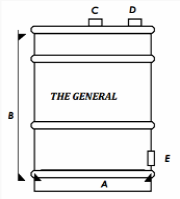Water Pollution Control Barrels
The General Water Pollution Control Barrels are low cost, self-contained water purification adsorbers designed to treat liquid streams of up to 20 GPM. The units are available in three different sizes to better serve your treatment needs, 55 gallon, 85 gallon and 110 gallon.
Specifications |
55 Gallon | 85 Gallon | 110 Gallon |
| Diameter, Outside: | 24″ | 28″ | 32″ |
| Height, Outside: | 35″ | 39″ | 43″ |
| Inlet Fitting (FPT): | C-1″ | C-2″ | C-2″ |
| Outlet Fitting (FPT): | E-1″ | D-2″ | D-2″ |
| Drain Fitting (FPT): | E-1″ | E-1″ | E-1″ |
| Carbon Weight: | 165 lbs. | 300 lbs. | 400 lbs. |
| Max. Flow rate, GPM: | 10 | 15 | 20 |
| Max. Pressure, PSIG: | 10 | 7 | 7 |
| Max. Design Temp., F: | 140 | 140 | 140 |
| Flow Direction: | Downflow | Downflow | Downflow |
| Shipping Weight: | 215 lbs. | 400 lbs. | 500 lbs. |

Activated Carbon – The General liquid adsorbers are filled with virgin, high activity GC 8×30 carbon. Virgin GC 12×40, reactivated GC 8x30R or other special carbons are also available.
Removable Lid – 16-gauge lid with ring and bolt closure and poly clad cellulose gasket.
Connections – Metal connections with standard pipe threads insure easy, durable and leak proof hookup to your system. Unions or quick connect fittings are advised to make drum exchange easy.
Flow Distributors – Both inlet and outlet have low pressure drop, slotted Schedule 40 PVC distributors. Units work well in either an upflow or downflow manner when the start up procedures is followed. Stainless steel internals and drums are available for special applications.
Coatings – The General water pollution control barrels are coated on the inside with heat cured phenolic epoxy. The outside coating is industrial enamel. A polyethylene liner is available for extra corrosion resistance for the 55 gallon and 85 gallon units.
Installation & Startup – If possible, before the units are used for the first time, they should be filled with clean water for a period of 8 to 12 hours to allow the carbon to degas. A gentle backwash is also recommended to remove carbon fines that can cause excessive pressure drop through the unit. Multiple units are usually connected in series with testing between the units advised to determine when the first unit needs to be changed-out.
Maintenance – Once connected, The General requires no maintenance other than the monitoring of the influent and effluent liquid streams and the operating pressure of the system. Monitoring the liquid stream into the last Water Pollution Control Barrel in series mode is a recommended safeguard against breakthrough in the final outflow. When the concentration of contaminants in the outflow equals the concentration in the inflow, The General has reached its removal capacity and should be removed from service. The working life of each adsorber is dependent upon the type of contaminant in the water as well as its concentration and the liquid flow rate. A pressure relief device is advised to prevent damage to the canister in the event of excessive pressure buildup.
Recharging The General – Once the carbon is saturated by contaminants, the unit should be removed and replaced with a fresh one. To purchase replacement carbon or to arrange for a carbon change-out, please contact our office.
Disposal – Dispose of the spent carbon in accordance with Local, State and Federal regulations.
CAUTION!
Wet activated carbon removes oxygen from air causing a severe hazard to workers inside carbon vessels. Confined space/low oxygen procedures should be put in place before any entry is made. Such procedures should comply with all applicable Local, State and Federal guidelines.